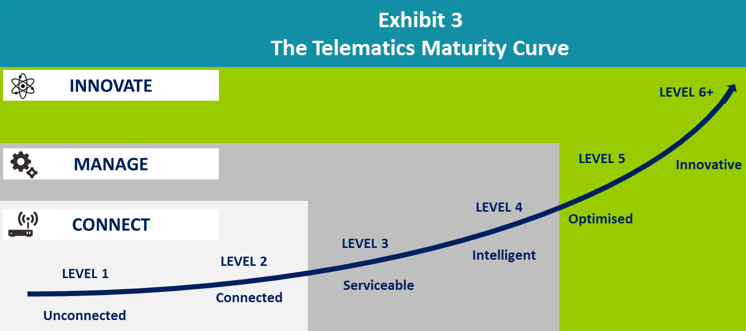Almost half of Australian road transport fleets are now using telematics systems. Although they’ve become business critical for many operators, there’s still much work to be done before the current focus on effective fleet management is replaced by service innovation. So how will the industry get there?
A recent survey, conducted for Teletrac Navman by ACA Research, shows 46% of Australian transport companies are using telematics to manage their fleet more efficiently (see Exhibit 1).

But many have yet to fully unlock the benefits of this investment. Road transport companies with telematics installed are using an average of six features (Exhibit 2). The most widely implemented are vehicle tracking, navigation, driver or vehicle performance monitoring and fatigue management.

It’s no surprise that vehicle tracking is easily the most commonly used feature. And yet although the ability to plot and visualise exact locations in real time is undoubtedly helpful, it’s not a game changer. Considering telematics adoption maturity (Exhibit 3), the value proposition increases progressively along the curve. Real value kicks in at Level 4 when systems are used to streamline businesses processes, improve productivity and inject operational efficiency into every link of the supply chain.

Our assessment of the Australian telematics market is that it’s transitioning towards Level 3. So how can you move your fleet up the maturity curve to Level 4 and beyond? While there’s no quick fix that will accelerate progression, the following tips will help put the necessary foundations in place.
- Integrate systems into a single insights platform: Many operators have invested in telematics as standalone systems, rather than integrating with fuel card data, enterprise resource planning (ERP) systems and accounting software. Consequently, the ability to address strategic business questions is limited.
- Ensure data is simple to understand and actionable: Telematics generates astonishingly large volumes of data so it’s easy to get lost in the detail. To avoid getting bogged down, ensure data delivers clear and actionable reports, with alerts set up to flag exceptions.
- Leverage data to inform the future: Data science is the new frontier for telematics. As global subscriber numbers increase, so does the volume of data collected. This can be used in numerous ways to improve fleet performance, such as building predictive models for equipment maintenance.
- Use data to gamify driver behaviour: Rather than adopting a punitive approach to non-compliance, use performance data to build a game-like incentive into driver safety programs. This will help meet your safety goals but modifications in driver behaviour will also reduce fuel consumption and maintenance bills.
- Employ a telematics specialist: This person needs a blend of technical, equipment, operation and fleet skills. Businesses often place great emphasis on technology but not enough on the skills required to extract full value from the investment. If you can’t justify a full-time role, consider upskilling an existing employee.
Telematics investment is part of a broader, ongoing digital transformation that’s helping to significantly streamline business operations and improve customer experience:
- Increased automation helps to drive down expenses while increasing productivity and performance.
- Managing vehicle dispatch, job allocations and route management more effectively has a positive impact on customer satisfaction.
- Real-time operations feedback, actionable reporting and predictive analytics are being used to generate better business decisions and inform future strategy.
Transport operators with a leadership that embraces this transformation are more likely to be leading change and to succeed in the long run. Those that adopt a more incremental approach risk being left behind while those who ignore digital technology do so at their peril. The future is unpredictable but telematics has an important role to play in the road freight transport industry. Only a fool would bet against an accelerating rate of change.

